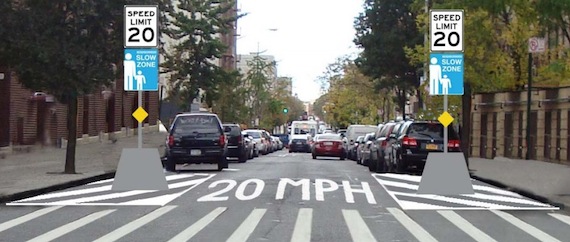
Last month DOT announced plans for the city's first 20 mph zone, located in the Claremont section of the Bronx. The agency's presentation to the local community board is now online [PDF], so you can see how DOT plans to implement the slow zone strategy in what could be the first of several neighborhoods. The approach is low-cost but should be effective: Every entrance to the area will be marked with a highly visible "gateway" announcing the reduced speed limit, and the neighborhood will be blanketed with regularly-spaced speed humps.
A number of factors led DOT to select this quarter square mile of Claremont for the city's first slow zone. There are five schools in the area, and the streets are relatively dangerous -- the number of injuries per mile is higher than almost three-quarters of NYC's streets. The DOT presentation also notes that Claremont has clearly defined boundaries, with an elevated train on the west and the Sheridan Expressway on the east, making it easier to set the zone apart from the other city streets.
When drivers enter that zone, it will be immediately clear that they are meant to slow down. At each entry point, large signs announcing the 20 mph zone and surface markings narrowing the right-of-way will replace one parking space on each side of the street. Compare the rendering above to a typical school zone treatment, where the signs don't figure so prominently within the motorist's field of vision:
Within the borders of the slow zone, DOT will add speed humps at regular intervals to physically enforce the 20 mph limit. Near the five schools, the speed humps will be spaced to keep traffic moving even slower, at 15 mph. Between the speed humps, markings on the street will regularly remind drivers of the speed limit.
The 20 mph zone approach has proved enormously successful in London. There, more than 400 slow zones have been put in place, covering 11 percent of the road length of the city. In some of them, speeds are controlled with physical traffic calming measures, and in others, cameras enforce the 20 mph limit. The total number of serious traffic fatalities and injuries has fallen by 46 percent within London's slow zones, according to the British Medical Journal, preventing an estimated 27 deaths and serious injuries each year.







